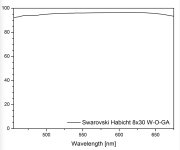hopster
Well-known member

Yes, you can of course also measure the optics, the question is whether this data reaches the eye of the beholder.
There are these eternal discussions about the "green" Zeiss, I myself see a noticeable "green dominance" in SF since the FL models, but Gij's laboratory findings contradict what is happening now, that SF remains "green" despite better knowledge.
It probably remains an unsolved question...!?
Andreas
There is inevitably going to be a correlation between a measured transfer function such as those plots and what the eye perceives, just as there is reliably in frequency responses of acoustic devices and their perceived audio balance (my old job).
Re: the green hue attributed to recent Zeiss (FL, HT and SF) you'll see all their plots having a similar characteristic to that one i.e. falling off both at the blue and red ends of the spectrum - leaving the green region standing above both. HT has relatively more blue making it brighter and a little 'colder' in tone (a better image in other ways though for me - I owned the HT 10x42 for a while and liked it a lot). Plots for these are also available on the house of outdoors and allbinos sites, and they match my own perceptions, many of which were experienced before seeing these plots.






